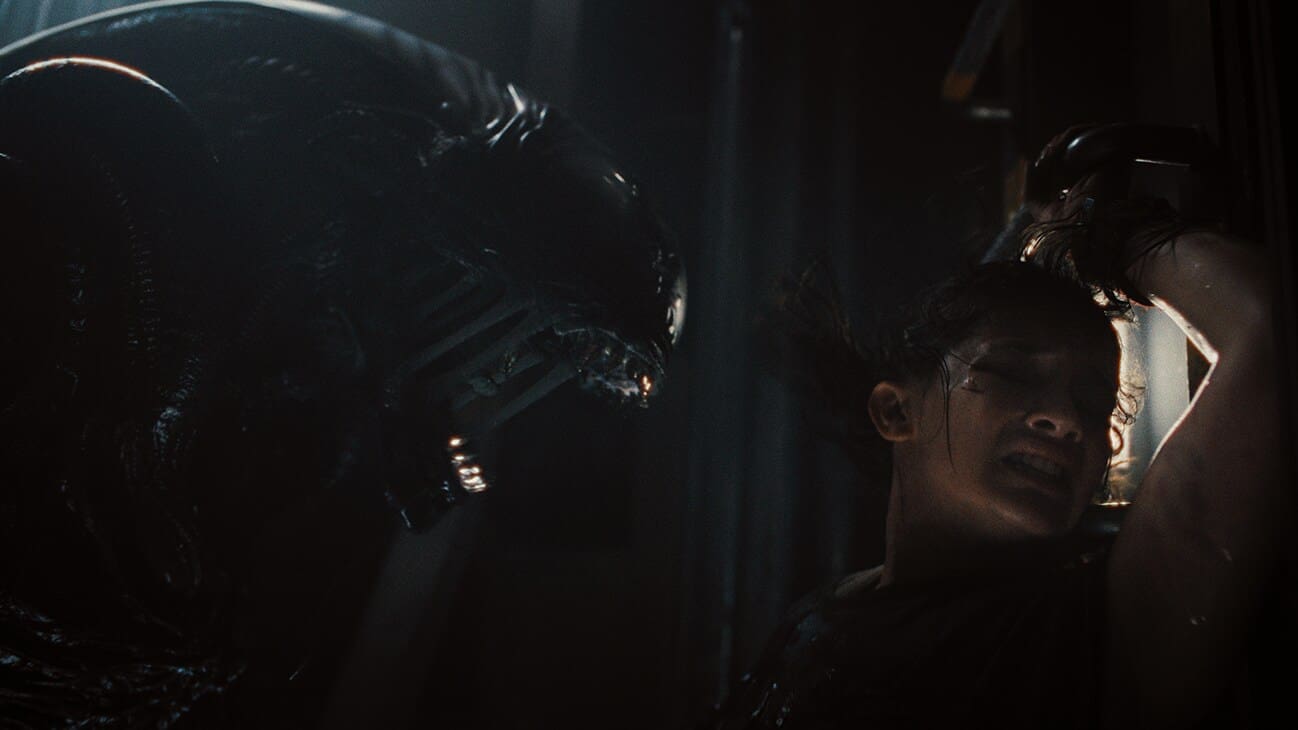
Alien: Romulus checks all the boxes that are expected from lega-sequels, but co-writer/director Fede Alvarez understands that part of the franchise’s effectiveness is the environment and how the squirmy and slimy threats fit within them. It’s from this understanding that Alvarez, his co-writer Rodo Sayagues, and the excellent cast and crew can unravel new situations, new dramatic opportunities and new threats, giving us a miraculous balancing act between the scale of the original Alien (1979) and its grander, action-oriented sequel, Aliens (1986).
Romulus‘s premise is an inversion of the original film, essentially putting Alvarez’s Don’t Breathe in space. Rather than working on a Weyland-Yutani space station like in Alien, Romulus‘s group of twentysomethings break into one (the titular Romulus) to steal its cryo-chambers. Like the twentysomethings in Don’t Breathe, they are thieves who are blissfully unaware of the threat they’re breaking into. Rain (Cailee Spaeny) and her adoptive-android brother Andy (David Jonsson), the heart of the film, are tired of life-threatening labor on their mining colony and want to make the 9-year trip to a paradise called Yvaga. We can already see Alvarez and Sayagues tapping into concepts from both the franchise and their own interests, and these interests compound the second the characters enter space. With its zero-gravity sequences, photo-real CGI, and magnificent texture in simple moments, Romulus expands on the timeless texture of the original Alien, which used the tangibility of its environment to complement the tension. The death of Brett (Harry Dean Stanton) in the original film is effective, in part, because of the dripping water, the sounds of the moving chains, all giving the world a tactile feel as a place the xenomorph can hide.
So, when the characters leave the atmosphere toward the Romulus in their little spaceship, the camera violently shakes for the interior shots and barely holds onto the ship for the CG exteriors. These exteriors are overwhelmed with garish rain and dark yellow clouds, but this is all juxtaposed by a softer, extremely wide shot as the ship enters space. Rain looks out the window, in awe, asking “is that…?” We wonder: what’s astonishing her? Is it Romulus? Nope: she’s talking about the light of the sun. In this futuristic world, our protagonist is in awe of something we see every day. This means we weren’t just seeing a rainy day on their colony, but their every day, and now we know what they wish to escape.
Conversely, an unsettling physicality takes over aboard the Romulus. Upon entering, characters crawl on their stomachs through a tight vent, with only the immediate space around them illuminated. Whether it’s a close-up or a wide shot, they are surrounded by vast darkness. This situation is already tense, but when the previously flat camera tilts counter clockwise, the station bellows like a beast, the previously terrestrial tension takes on a new form. The gravity generators are barely functional, so the characters aren’t just stuck between two tight surfaces like you or I could be on Earth: they’re stuck between two tight surfaces as they and the objects around them float around unexpectedly in zero gravity.
Alien: Romulus adds a twist to its environment with Andy. A Weyland-Yutani creation, Andy can open Romulus’s front door, but lacks the authorization for other rooms, so Rain replaces his programming with that of a derelict android left behind. This seems simple enough, until we learn Andy’s new programming changed his directive to something unknown. They don’t know if their guide has their interests at heart, or even if he knows. Jonsson’s performance is an elegant miracle, perpetually uncertain of the world around him, even as he tries to make his sister smile with Dad jokes their father programmed into him. His subtle, uncertain turn is both tragic and tense, throwing wrenches in the dramatic gears. Bjorn (Spike Fearn), for instance, is a dick who mistreats Andy, because an android once chose to save the lives of numerous people over the life of Bjorn’s Mom. Alvarez and Sayagues allow this empathy to give a bittersweetness to Bjorn’s callous heart, rather than making him a misunderstood meanie. When Andy appears to choose the life of the crew over Bjorn’s partner Navarro (Aileen Wu), Bjorn’s impulsive response is less a respectable move than it is meant to leave the audience saying “dude, I get where you’re coming from, but come ON.”
Naturally, tensions grow when facehuggers and xenomorphs show up, and here the balancing act between the scale of Alien and Aliens factors in. One scene, where Rain and Andy sneak through a hallway infested with facehuggers, is particularly inspired. Throughout the franchise, the threat of a hatched facehugger rarely, if ever, involves more than one or two facehuggers, (think Ripley and Newt being trapped by Burke in Aliens). This scene compounds the scale Aliens did, while keeping it rooted in the original film’s explicitly horror roots.
However, it’s the film’s build up from one xenomorph to a community of them that heightens this balancing act. Through this single xenomorph’s birth (in a subtly unique chest-burst) and evolution, the film affirms the threat of just one of these suckers. When Kay (Isabella Merced) is trapped in a room, waiting for Andy, Rain, and her brother Tyler (Archie Renaux) to get her out, the xenomorph waits. It’s content catching one victim, but still has the patience to wait for a few more. So, when a character comes face-to-face with this single xenomorph only to turn and see a swarm of them, the threat becomes immeasurably compounded. It’s not Romulus‘s callbacks, but this moment, where the legacies of Alien and Aliens feel harmonized. Even as a fan of all the Alien movies (excluding the dreadful AvP: Requiem), even if Romulus isn’t the best of the sequels, this moment stands out as the most effective reconciliation of Alien and Aliens since 1986.
For all that it does right, Alien: Romulus does one thing wrong: digitally resurrect a late acting legend to “reprise” a role from the franchise. Alvarez recently stated that the family was on board and he had other justifications regarding the actor’s supposed desire to play the role again, desires conveyed by the late actor’s spouse. This justification is as good as you can get with digital necromancy, but it’s, at best, an awkward and unnecessary inclusion, and is at worst unsettling. This is a shame, because it’s Romulus‘s only demerit. It’s a movie that’s so simple, so textured, so rich and so tense, but with all that’s going on in the world of AI, it is a demerit that already has, and will continue to, make viewers uncomfortable.
That said, if you’re able to bite the bullet and enjoy the movie despite it, you will find plenty of visceral, tense thrills aboard the Romulus.

